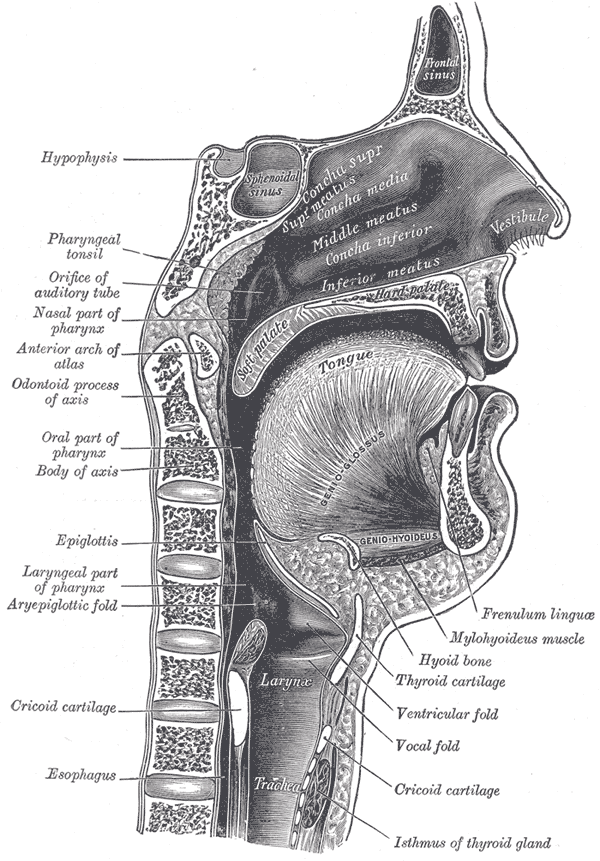|
Alterego
AlterEgo is a wearable silent speech output-input device developed by MIT Media Lab. The device is attached around the head, neck, and jawline and translates your brain speech center impulse input into words on a computer, without vocalization. Description The device consists of 7 small electrodes that attach at various points around the jaw-line and mouth to receive the electrical inputs to the muscles used for speech. It looks similar to a sling for the head, neck and jaw. Background Scientists Arnav Kapur of Fluid Interfaces group at MIT Media Lab with Shreyas Kapur and Pattie Maes designed the prototype and presented the work at the Conference on Intelligent User Interfaces in March 2018, in Tokyo. They reported that, when testing the accuracy of a classifier trained on data where users were instructed to "read the number to themselves, without producing a sound and moving their lips," they were able to classify the digit (between 0 and 9, i.e., ten classes), with 92 percen ... [...More Info...] [...Related Items...] OR: [Wikipedia] [Google] [Baidu] |
MIT Media Lab
The MIT Media Lab is a research laboratory at the Massachusetts Institute of Technology, growing out of MIT's Architecture Machine Group in the School of Architecture. Its research does not restrict to fixed academic disciplines, but draws from technology, media, science, art, and design. , Media Lab's research groups include neurobiology, biologically inspired fabrication, socially engaging robots, emotive computing, bionics, and hyperinstruments. The Media Lab was founded in 1985 by Nicholas Negroponte and former MIT President Jerome Wiesner, and is housed in the Wiesner Building (designed by I. M. Pei), also known as Building E15. The Lab has been written about in the popular press since 1988, when Stewart Brand published ''The Media Lab: Inventing the Future at M.I.T.'', and its work was a regular feature of technology journals in the 1990s. In 2009, it expanded into a second building. The Media Lab came under scrutiny in 2019 due to its acceptance of donations from ... [...More Info...] [...Related Items...] OR: [Wikipedia] [Google] [Baidu] |
Pattie Maes
Pattie Maes (born 1961) is a professor in MIT's program in Media Arts and Sciences. She founded and directed the MIT Media Lab's Fluid Interfaces Group. Previously, she founded and ran the Software Agents group. She served for several years as both the head and associate head of the Media Lab's academic program. Prior to joining the Media Lab, Maes was a visiting professor and a research scientist at the MIT Artificial Intelligence Lab. She holds bachelor's and PhD degrees in computer science from the Vrije Universiteit Brussel in Belgium. Maes' areas of expertise are human–computer interaction, intelligent interfaces and ubiquitous computing. Maes is the editor of three books, and is an editorial board member and reviewer for numerous professional journals and conferences. She has received several awards: Newsweek magazine named her one of the "100 people for the new century"; TIME Digital selected her as a member of the ''Cyber-Elite'' (the top 50 technological pioneers of ... [...More Info...] [...Related Items...] OR: [Wikipedia] [Google] [Baidu] |
Tokyo
Tokyo (; ja, 東京, , ), officially the Tokyo Metropolis ( ja, 東京都, label=none, ), is the capital and largest city of Japan. Formerly known as Edo, its metropolitan area () is the most populous in the world, with an estimated 37.468 million residents ; the city proper has a population of 13.99 million people. Located at the head of Tokyo Bay, the prefecture forms part of the Kantō region on the central coast of Honshu, Japan's largest island. Tokyo serves as Japan's economic center and is the seat of both the Japanese government and the Emperor of Japan. Originally a fishing village named Edo, the city became politically prominent in 1603, when it became the seat of the Tokugawa shogunate. By the mid-18th century, Edo was one of the most populous cities in the world with a population of over one million people. Following the Meiji Restoration of 1868, the imperial capital in Kyoto was moved to Edo, which was renamed "Tokyo" (). Tokyo was devastate ... [...More Info...] [...Related Items...] OR: [Wikipedia] [Google] [Baidu] |
Silent Speech Interface
Silent speech interface is a device that allows speech communication without using the sound made when people vocalize their speech sounds. As such it is a type of electronic lip reading. It works by the computer identifying the phonemes that an individual pronounces from nonauditory sources of information about their speech movements. These are then used to recreate the speech using speech synthesis. Information sources Silent speech interface systems have been created using ultrasound and optical camera input of tongue and lip movements. Electromagnetic devices are another technique for tracking tongue and lip movements. The detection of speech movements by electromyography of speech articulator muscles and the larynx is another technique. Another source of information is the vocal tract resonance signals that get transmitted through bone conduction called non-audible murmurs. They have also been created as a brain–computer interface using brain activity in the motor corte ... [...More Info...] [...Related Items...] OR: [Wikipedia] [Google] [Baidu] |
Imagined Speech
Imagined speech (also called silent speech, covert speech, inner speech, or, in the original Latin terminology used by clinicians, endophasia) is thinking in the form of sound – “hearing” one’s own voice silently to oneself, without the intentional movement of any extremities such as the lips, tongue, or hands.Brigham, K.; Vijaya Kumar, B.V.K.,Imagined Speech Classification with EEG Signals for Silent Communication: A Preliminary Investigation into Synthetic Telepathy, June 2010 Logically, imagined speech has been possible since the emergence of language, however, the phenomenon is most associated with its investigation through signal processingBrigham, K.; Vijaya Kumar, B.V.K.,Subject Identification from Electroencephalogram (EEG) Signals During Imagined Speech, September 2010. and detection within electroencephalograph (EEG) dataA. Porbadnigk; M. Wester; Schultz, T.,EEG-Based Speech Recognition: Impact of Temporal Effects", 2009. as well as data obtained using alternativ ... [...More Info...] [...Related Items...] OR: [Wikipedia] [Google] [Baidu] |
Subvocalization
Subvocalization, or silent speech, is the internal speech typically made when reading; it provides the sound of the word as it is read.Carver, R. P. (1990) Reading Rate: A Comprehensive Review of Research and Theory (1990)Cleland, D. L., Davies, W. C and T. C. 1963. Research in Reading. ''The Reading Teacher'', ''16''(4), 224-228 This is a natural process when reading and it helps the mind to access meanings to comprehend and remember what is read, potentially reducing cognitive load.Rayner, Keith and Pollatsek, Alexander (1994) The Psychology of Reading This inner speech is characterized by minuscule movements in the larynx and other muscles involved in the articulation of speech. Most of these movements are undetectable (without the aid of machines) by the person who is reading. It is one of the components of Alan Baddeley and Graham Hitch's phonological loop proposal which accounts for the storage of these types of information into short-term memory.Smith, J. D., Wilson, M., & ... [...More Info...] [...Related Items...] OR: [Wikipedia] [Google] [Baidu] |
Artificial Neural Networks
Artificial neural networks (ANNs), usually simply called neural networks (NNs) or neural nets, are computing systems inspired by the biological neural networks that constitute animal brains. An ANN is based on a collection of connected units or nodes called artificial neurons, which loosely model the neurons in a biological brain. Each connection, like the synapses in a biological brain, can transmit a signal to other neurons. An artificial neuron receives signals then processes them and can signal neurons connected to it. The "signal" at a connection is a real number, and the output of each neuron is computed by some non-linear function of the sum of its inputs. The connections are called ''edges''. Neurons and edges typically have a ''weight'' that adjusts as learning proceeds. The weight increases or decreases the strength of the signal at a connection. Neurons may have a threshold such that a signal is sent only if the aggregate signal crosses that threshold. Typically, ... [...More Info...] [...Related Items...] OR: [Wikipedia] [Google] [Baidu] |
Internet Of Things
The Internet of things (IoT) describes physical objects (or groups of such objects) with sensors, processing ability, software and other technologies that connect and exchange data with other devices and systems over the Internet or other communications networks. Internet of things has been considered a misnomer because devices do not need to be connected to the public internet, they only need to be connected to a network and be individually addressable. The field has evolved due to the convergence of multiple technologies, including ubiquitous computing, commodity sensors, increasingly powerful embedded systems, as well as machine learning.Hu, J.; Niu, H.; Carrasco, J.; Lennox, B.; Arvin, F.,Fault-tolerant cooperative navigation of networked UAV swarms for forest fire monitoring Aerospace Science and Technology, 2022. Traditional fields of embedded systems, wireless sensor networks, control systems, automation (including Home automation, home and building automation), indepen ... [...More Info...] [...Related Items...] OR: [Wikipedia] [Google] [Baidu] |
Wearable Devices
Wearable technology is any technology that is designed to be used while worn. Common types of wearable technology include smartwatches and smartglasses. Wearable electronic devices are often close to or on the surface of the skin, where they detect, analyze, and transmit information such as vital signs, and/or ambient data and which allow in some cases immediate biofeedback to the wearer.Düking P, Hotho A, Holmberg HC, Fuss FK, Sperlich B. Comparison of Non-Invasive Individual Monitoring of the Training and Health of Athletes with Commercially Available Wearable Technologies. Frontiers in physiology. 2016;7:71. . Wearable devices such as activity trackers are an example of the Internet of Things, since "things" such as electronics, software, sensors, and connectivity are effectors that enable objects to exchange data (including data quality) through the internet with a manufacturer, operator, and/or other connected devices, without requiring human intervention. Wearable technolo ... [...More Info...] [...Related Items...] OR: [Wikipedia] [Google] [Baidu] |
Wearable Computers
A wearable computer, also known as a body-borne computer, is a computing device worn on the body. The definition of 'wearable computer' may be narrow or broad, extending to smartphones or even ordinary wristwatches. Wearables may be for general use, in which case they are just a particularly small example of mobile computing. Alternatively, they may be for specialized purposes such as fitness trackers. They may incorporate special sensors such as accelerometers, heart rate monitors, or on the more advanced side, electrocardiogram (ECG) and blood oxygen saturation (SpO2) monitors. Under the definition of wearable computers, we also include novel user interfaces such as Google Glass, an optical head-mounted display controlled by gestures. It may be that specialized wearables will evolve into general all-in-one devices, as happened with the convergence of PDAs and mobile phones into smartphones. Wearables are typically worn on the wrist (e.g. fitness trackers), hung from the nec ... [...More Info...] [...Related Items...] OR: [Wikipedia] [Google] [Baidu] |
.jpg)


.jpg)

